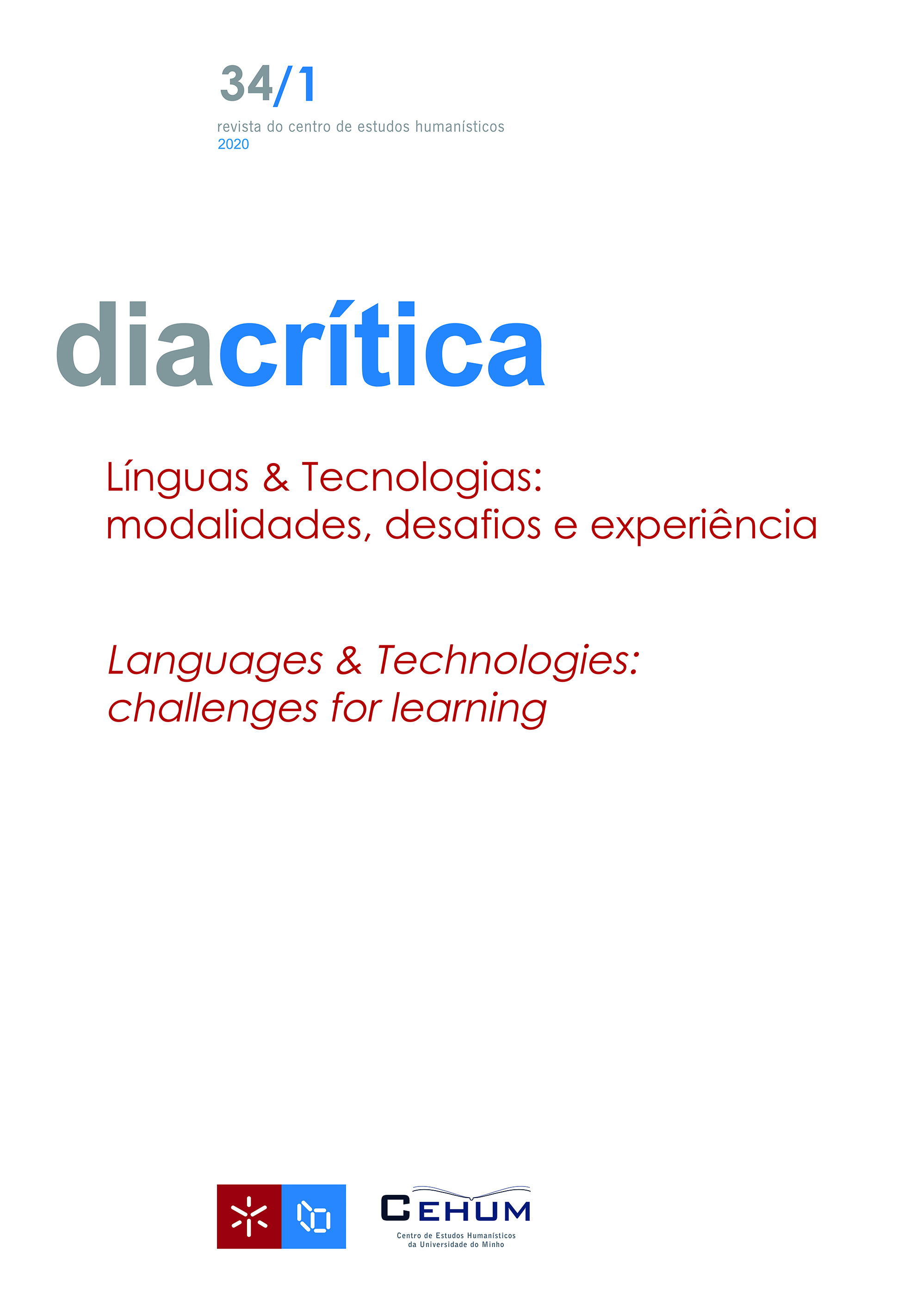Poderão os tablets nas aulas de ile ter impacto na motivação dos alunos para aprender inglês?
DOI:
https://doi.org/10.21814/diacritica.4972Palavras-chave:
Aprendizagem de Línguas Assistida por Tecnologias Móveis (MALL), Tablets, Inglês –Língua Estrangeira (ILE), Motivação. Um-para-um (1:1), Aprendizagem enriquecida por tecnologiaResumo
O objetivo deste estudo é entender se haverá um impacto na motivação dos alunos para aprender inglês como língua estrangeira quando se recorre a tecnologias móveis para apoiar atividades de aprendizagem ativas que desenvolvam as competências de produção oral dos alunos. Os participantes foram dois professores e os seus 106 alunos, divididos em 3 turmas de7.º e 1 de8.ºano, que usavam os próprios tablets na escola. Essa utilização resultou de um projeto da escola para promover a integração de tecnologias nas atividades da sala de aula. No início e no final do ano letivo, os alunos responderam a um questionário que continha três dimensões de um índice de motivação, retirado da “Bateria de Testes de Atitude/Motivação” de Gardner. Após uma análise preliminar a esses dados quantitativos, foi criado o instrumento de recolha de dados qualitativos–um protocolo de entrevista aplicado a dois professores. Após a análise dos dados qualitativos, todos os dados foram analisados em conjunto e esses resultados examinados. Assim, este desenho de investigação com métodos mistos seguiu uma estratégia explanatória sequencial, uma vez que os últimos dados permitiram uma análise mais aprofundada dos dados iniciais. Os resultados revelaram uma tendência favorável em termos de motivação dos alunos, embora se tivessem encontrado diferenças estatisticamente significativas apenas no caso dos alunos com níveis iniciais de motivação mais baixos e moderados. Ambos os professores referiram melhorias na participação e envolvimento dos alunos nas atividades em sala de aula.
Referências
says – ipads in the classroom. London: London Knowledge Lab – Institute of Education University of London.
Cohen, L., Manion, L. & Morrison, K. (2007). Research methods in education. London: Routledge. DOI: https://doi.org/10.4324/9780203029053
Commission of the European Communities (2003). Promoting Language Learning and Linguistic Diversity: An Action Plan 2004–2006. 449. <https://eur-lex.europa.eu/legal-content/EN/TXT/PDF/?uri=CELEX:52003DC0449&from=EN>. Consulted on: 1st December 2018.
Creswell, J. W., Plano Clark, V. L., Gutmann, M. L. & Hanson, W. E. (2003). Advanced mixed methods research designs. In A. Tashakkori & C. Teddlie (Eds.), Handbook of mixed methods in social and behavioral research (pp. 209–240). Thousand Oaks, CA: Sage.
Dörnyei, Z. (1994). Motivation and motivating in the foreign language classroom. The Modern Language Journal, 78 (3), 273–284. DOI: https://doi.org/10.1111/j.1540-4781.1994.tb02042.x
Dörnyei, Z. (1998). Motivation in second and foreign language learning. Language Teaching, 31, 117–135. DOI: https://doi.org/10.1017/S026144480001315X
Ensor, T. (2012). Teaming with technology: “Real” ipad applications. International Reading Association: Journal of Adolescent & Adult Literacy, 56 (3), 193. DOI: https://doi.org/10.1002/JAAL.00127
European Commission (2014). Measuring digital skills across the EU: EU wide indicators of digital competence. <https://ec.europa.eu/digital-agenda/en/news/measuring-digital-skills-across-eu-eu-wide-indicators-digital-competence>. Consulted on: 1st December 2018.
Ferrari, A., Brečko, B. & Punie, Y. (2014). DIGCOMP: A framework for developing and understanding digital competence in Europe. Digital Literacies and eCompetence, eLearning Papers, 38, 3–16.
Gardner, R. C. (1985). The Attitude/Motivation Test Battery: Technical Report. Ontario, Canada: University of Western Ontario.
Gardner, R. C. (2004). Attitude Motivation Test Battery: International AMTB project. <http://hyxy.nankai.edu.cn/jingpinke/buchongyuedu/Motivation%20measurement-AMTB.pdf>. Consulted on: 1st December 2018.
Gawelek, M.A., Spataro, M. & Komarny, P. (2011). Mobile perspectives: On ipads – why mobile? EDUCAUSE Review, 46 (2), 28–32.
chemistry laboratory course. Journal of STEM Education, 14 (2), 5–9.
Higgins, S., Xiao, Z. & Katsipataki, M. (2012) The impact of digital technology on learning: A summary for the education endowment foundation – full report. Durham, UK: Education Endowment Foundation – Durham University.
Huber, S. (2012). Ipads in the classroom – A development of a taxonomy for the use of tablets in schools (PhD thesis, Graz University of Technology, Graz, Austria).
Hutchison, A., Beschorner, B. & Schmidt-Crawford, D. (2012). Exploring the use of the ipad for literacy learning. International Literacy Association – The Reading Teacher, 66 (1), 15–23. DOI: https://doi.org/10.1002/TRTR.01090
Karsenti, T. & Fievez, A. (2013). The ipad in education: uses, benefits, and challenges – A survey of 6,057 students and 302 teachers in Quebec, Canada. Montreal, Canada: CRIFPE.
Kukulska-Hulme, A., Norris, L. & Donohue, J. (2015). Mobile pedagogy for English language teaching: a guide for teachers. London: British Council.
Kukulska-Hulme, A. (2009). Will mobile learning change language learning? ReCALL, 21 (2), 157–165. DOI: https://doi.org/10.1017/S0958344009000202
Madrid, D. & Pérez Cañado, M. L. (2001). Exploring the student’s motivation in the EFL class. In E. García Sánchez (Ed.) Present and Future Trends in TEFL, 321–364.
O’Malley, P., Jenkins, S., Wesley, B., Donehower, C., Rabuck, D. & Lewis, M. (2013). Effectiveness of using iPads to build Math fluency. Proceedings of annual meeting of the Council for Exceptional Children. San Antonio - Texas: Council for Exceptional Children.
Pegrum, M., Oakley, G. & Faulkner, R. (2013). Schools going mobile: A study of the adoption of mobile handheld technologies in Western Australian independent schools. Australasian Journal of Educational Technology, 29 (1), 66–81. DOI: https://doi.org/10.14742/ajet.64
Peluso, D. (2012). The fast-paced ipad revolution: Can educators stay up to date and relevant about these ubiquitous devices? British Journal of Educational Technology, 43 (4), 125–127. DOI: https://doi.org/10.1111/j.1467-8535.2012.01310.x
Traxler, J. (2009). Learning in a mobile age. International Journal of Mobile and Blended Learning, 1 (1), 1–12. DOI: https://doi.org/10.4018/jmbl.2009010101
Traxler, J. (2011). Aprendizagem móvel e recursos educativos digitais do futuro. Cadernos ERTE - Sacausef, 7, 36–47.
West, M. & Vosloo, S. (2013). UNESCO policy guidelines for mobile learning. Paris: UNESCO. <https://unesdoc.unesco.org/ark:/48223/pf0000219641?posInSet=1&queryId=777a51d3-1e51-47df-b238-f41660af4321>. Consulted on: 1st December 2018.
Downloads
Publicado
Como Citar
Edição
Secção
Licença
Direitos de Autor (c) 2023 Sílvia Roda Couvaneiro, Neuza Pedro

Este trabalho encontra-se publicado com a Creative Commons Atribuição-NãoComercial 4.0.










